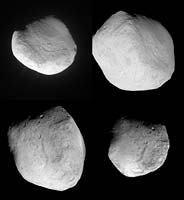|
COMETS EARTH JUPITER KUIPER BELT MARS MERCURY METEORITES NEPTUNE OORT CLOUD PLUTO SATURN SOLAR SYSTEM SPACE SUN URANUS VENUS ORDER PRINTS
PHOTO CATEGORIES SCIENCEVIEWS AMERICAN INDIAN AMPHIBIANS BIRDS BUGS FINE ART FOSSILS THE ISLANDS HISTORICAL PHOTOS MAMMALS OTHER PARKS PLANTS RELIGIOUS REPTILES SCIENCEVIEWS PRINTS
|
Related Documents
Download Options
This image mosaic shows four different views of comet Tempel 1 as seen by NASA's Stardust spacecraft as it flew by on Feb. 14, 2011. The images progress in time beginning at upper left, moving to upper right, then proceeding from lower left to lower right. When the spacecraft first approached, it got a clear look at the same surface that was imaged previously by NASA's Deep Impact mission in 2005. Deep Impact sent a projectile into the comet, creating a crater that is located in the upper left image, but is difficult to see at this particular contrast level. As Stardust flew closer to the comet, it began to see new territory that had not been imaged before. The new territory appears on the left side of the upper right image. The Deep Impact crater is also located in this view, on the right side. Both the upper right and lower left images are the closest approach images for Stardust, taken at 3 seconds before, and 3 seconds after, the closest approach. The images were taken from a distance of about 185 kilometers (115 miles). In the lower left image, the vast majority of terrain pictured had not been seen until now. The fourth image, at lower right, shows Stardust's view as the spacecraft was on the way out. The image at upper left was taken 15 seconds before the encounter, or closest approach, from a distance of 244 kilometers (152 miles); the image at lower right was taken 15 seconds after encounter, from a distance of 245 kilometers (152 miles). Stardust-NExT is a low-cost mission that will expand the investigation of comet Tempel 1 initiated by NASA's Deep Impact spacecraft. JPL, a division of the California Institute of Technology in Pasadena, manages Stardust-NExT for the NASA Science Mission Directorate, Washington, D.C. Joe Veverka of Cornell University, Ithaca, N.Y., is the mission's principal investigator. Lockheed Martin Space Systems, Denver, built the spacecraft and manages day-to-day mission operations. |
